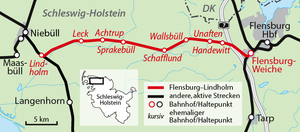Railway line Flensburg-Weiche – Lindholm
| Flensburg-Weiche-Lindholm | |||||||||||||||||||||||||||||||||||||||||||||||||||||
|---|---|---|---|---|---|---|---|---|---|---|---|---|---|---|---|---|---|---|---|---|---|---|---|---|---|---|---|---|---|---|---|---|---|---|---|---|---|---|---|---|---|---|---|---|---|---|---|---|---|---|---|---|---|
| Route number (DB) : | 1001 | ||||||||||||||||||||||||||||||||||||||||||||||||||||
| Course book section (DB) : | 134 (1981) | ||||||||||||||||||||||||||||||||||||||||||||||||||||
| Route length: | 36.2 km | ||||||||||||||||||||||||||||||||||||||||||||||||||||
| Gauge : | 1435 mm ( standard gauge ) | ||||||||||||||||||||||||||||||||||||||||||||||||||||
|
|||||||||||||||||||||||||||||||||||||||||||||||||||||
The Flensburg-Weiche - Lindholm railway line is a single-track, non-electrified branch line in the north of Schleswig-Holstein . It runs parallel to the border to Denmark and is no longer used by scheduled trains because it has been operationally closed by DB Netz AG . It connects the city of Flensburg on the Baltic Sea coast with the town of Lindholm on the Marschbahn near the North Sea coast.
history
In 1887 the march line was completed in the west of Schleswig-Holstein . North of Flensburg there was the east-west route Tondern – Tingleff , south the route Jübek – Husum . A direct connection from Flensburg to the west, which also served the numerous localities, was then planned in the 1880s. The line was inaugurated on October 1, 1889 by the Prussian State Railways. It primarily served the delivery and removal of agricultural goods. Raseneisenstein was driven out of Schafflund by 1948 . In addition to passenger traffic, the line was also used to transfer locomotives from the Flensburg railway depot to the Marschbahn. The Unaften stop was only established in 1905. Class 64 steam locomotives ran from 1928 to 1940 , and class 50 from 1943 . From around 1950 the passenger trains were pulled by the V 36 before passenger transport was taken over by rail buses of the VT 98 series at the end of 1961 . From the summer of 1963 diesel locomotives of the V 100 and V 60 series were used.
In 1969 the top speed was increased to 80 km / h. The highest quality service in passenger transport was the Sylter Welle express train pair, which ran in midsummer, until it was discontinued in 1980 . This usually associated with a diesel locomotive class 218 hauled train had the path Kiel - Westerland (Sylt) . Scheduled stopovers on the route were Flensburg-Weiche and Leck . In addition, around five pairs of passenger trains ran on the Flensburg - Niebüll route in the 1970s , and with one exception they were driven by class 798 (formerly VT 98) rail buses . They had been replaced by buses on Sundays and public holidays since the late 1950s. There was also parallel bus service on weekdays.
attitude
Scheduled passenger traffic was discontinued on May 31, 1981. Niebüller Nordfriesische Verkehrsbetriebe AG (NVAG) offered several times to continue operating the route if the passenger trains were allowed to run to the former station in Flensburg in the city center. After the shutdown, there was occasional freight and museum traffic. From 1984 onwards, driving on the Leck – Sprakebüll section was only permitted with a special permit. The entire route had to be reserved for a maximum route speed. On May 27, 1990, the line was permanently closed, with special permission, trains, such as tourist trains of the fishing railway and the NVAG, could continue to run. Freight traffic on the western part to Wallsbüll ceased on December 31, 1990, and on the remaining eastern section on July 6, 1999. After the shutdown, a recreational operation with draisines was opened between Leck and Unaften .
For strategic reasons within the framework of the NATO concept, the line was initially retained. Today these motivations have ceased; the route was interrupted at several road crossings from 2010. Recommissioning has been considered several times, but has never been implemented. In the local traffic plan of the state of Schleswig-Holstein, the connection is provided as an option for a later reactivation. It could also help to relieve the pressure on the Marschbahn , as the use of the electrified Flensburg – Hamburg route would enable attractive travel times in Hamburg – Sylt traffic.
Local transport is carried out by express bus via the largely parallel B 199 . However, the bus travels through the towns, so a journey takes longer than it did until 1981 by train and can no longer be booked in the DB tariff. Therefore, DB customers take the detour via Jübek or Schleswig as well as Husum .
Section in turnout (2014)
Level crossing at the former Briesen barracks (2014)
Level crossing in the Wallsbüller Forest (2014)
literature
- Georg Böhm: 120 years of the Lindholm – Leck – Flensburg-Weiche railway line . In: Between Eider and Wiedau - North Friesland 2009 . North Frisian Association and Heimatbund Eiderstedt, Husum 2009, ISBN 978-3-89876-406-3 , pp. 100-107.
- Dumjahn: manual of the German railway lines . Dumjahn 1984, ISBN 3-921426-29-4 .
Web links
- V 36 - across the country (1957)
- Train traffic through the train station Leck (1963)
- Historic route map of Schleswig-Holstein
- Current trolley traffic
Individual evidence
- ↑ a b c d Georg Böhm: 120 years of the Lindholm – Leck – Flensburg-Weiche railway line , in: Between Eider and Wiedau - North Friesland 2009 . North Frisian Association and Heimatbund Eiderstedt, Husum 2009, ISBN 978-3-89876-406-3 .




